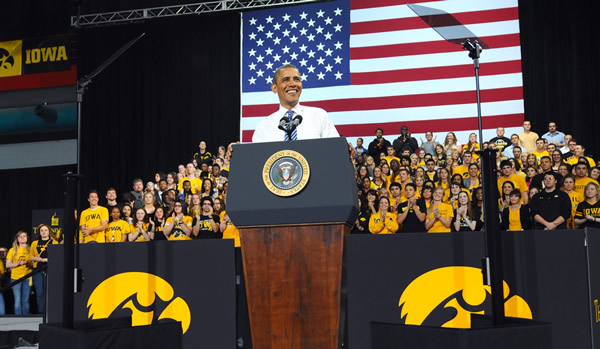In 2007, Congress halved the federal student loan rate to 3.4 percent but triggered the rates to increase to 6.8 in 2012. Now, Washington policymakers are debating whether or not to extend the 3.4 percent rate and hand the $6 billion “tuition” bill on to taxpayers.
Despite claims by President Obama on his tour of college campuses this week that keeping the loan rate artificially low is critical to keeping college affordable, the numbers suggest otherwise, as Douglas Holz-Eakin, former head of the Congressional Budget Office, points out on National Review Online.
Keeping the rates at 3.4 percent, he explains, would reduce monthly student loan payments, on average, by only $7. Plus, the lower rate applies only to new borrowers and those students who receive federally funded Stafford loans.
But despite providing little help to students, the proposal carries a significant price tag for taxpayers. The $6 billion cost will be borne by all Americans, even the nearly three-quarters of taxpayers who don’t hold a college degree. As John Stossel points out, “Only 30 percent of Americans have a college degree. People with degrees are relatively elite. Government shouldn’t force the remaining 70 percent to subsidize them.”
The 70 percent are subsidizing federal student loans that go out to millions of students without regard to risk (whether or not they can handle college-level work). Plus, those loans are offered at rates far below what private lenders would offer, since private lenders can’t pass on the risk to taxpayers like the federal government does. Higher education scholar Neal McCluskey points out that easy access to low-interest loans hasn’t helped increase college affordability:
First and foremost, all the cheap aid has enabled colleges to raise their prices at breakneck speeds, rendering the aid largely self-defeating and college pricing insane.
Second, giving dirt-cheap ducats to wannabe students—no matter how poorly prepared they are, or how little they actually want to tackle college work—has resulted in massive overconsumption and noncompletion of postsecondary education, and left millions without the earnings-upping degrees they need to pay their college debts.… Finally, there’s the cost to taxpayers. Overall, federal student loans originated in just 2010-11 involved $104 billion in taxpayer money, and if those loans don’t get paid back, or interest rates are slashed, it is taxpayers who will take the hit.
The current student loan interest rate debacle has been preceded by massive increases federal involvement in higher education over the decades. But since President Obama came to office, he has significantly increased Washington’s reach on college campuses by:
- Further federalizing student lending with the Student Aid and Fiscal Responsibility Act, which was buried in Obamacare;
- Capping what lenders can require students to pay each month;
- Completely “forgiving” student loans after 20 years on the backs of taxpayers; and
- Putting into place policies that are hostile toward for-profit, online higher education institutions, such as requiring online provides to receive accreditation in all states in which they operate.
These government policies, however, will fail to drive down college costs in the long run. To tackle the rising costs of higher education, we need savings-based rather than debt-based college financing. Policymakers should also allow the free market to work to reduce college costs by, for example, creating better environments for online learning to flourish. Additionally, the federal government needs to stop increasing federal subsidies for higher education, which only incentivizes colleges to raise their tuition rates.
Policy should promote these types of cost-efficient approaches rather than expensive Washington plans that leave taxpayers footing the bill. That would be a win-win for all Americans.
